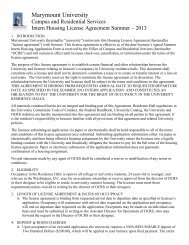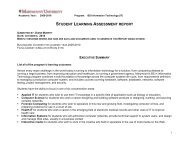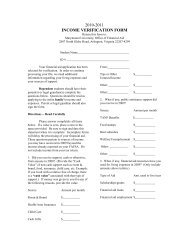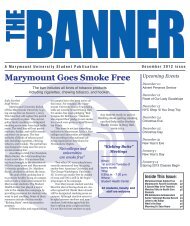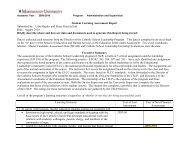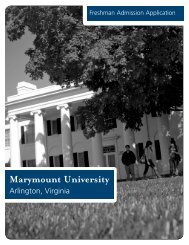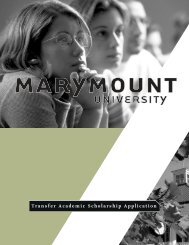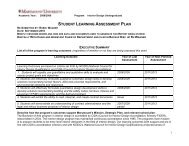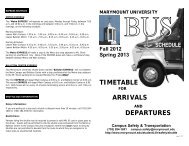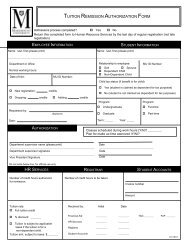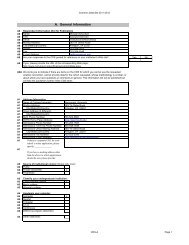EmployEE Handbook - Marymount University
EmployEE Handbook - Marymount University
EmployEE Handbook - Marymount University
Create successful ePaper yourself
Turn your PDF publications into a flip-book with our unique Google optimized e-Paper software.
1. Administrator (Executive)<br />
2. Faculty<br />
3. Other Administrative or Professional<br />
4. Computer-related<br />
1. Administrator (Executive)<br />
The status of administrator is assigned to those academic and administrative positions<br />
which involve major responsibility for management of the <strong>University</strong>, e.g. the president,<br />
vice presidents, deans, associate deans, and directors of major administrative units. This<br />
includes those administrators in charge of a principal business unit, division or function<br />
(such as marketing, administration or finance), or any other administrator who performs a<br />
university-wide policy making function. Administrative employees are defined as exempt<br />
from the minimum wage, overtime, and record keeping provisions of the Fair Labor<br />
Standards Act.<br />
2. Faculty<br />
The Faculty of the <strong>University</strong> comprises all persons holding academic rank whose<br />
principal responsibility at <strong>Marymount</strong> <strong>University</strong> is to provide or administer academic<br />
instruction or services, for 9 (nine), ten (10), or twelve (12) months of the year. Members<br />
of the faculty are divided into three areas: those whose principal responsibility is teaching<br />
and designing courses and curricula and advising students; those whose principal<br />
responsibilities are administering academic programs and courses of studies of enrolled<br />
students; those whose principal responsibilities are providing library and learning<br />
services.<br />
3. Other Administrative or Professional Employees<br />
Professional exempt employees are degreed staff who perform highly specialized<br />
duties within a department. Work is performed under general supervision and requires<br />
special training, experience, or knowledge. To be classified as Professional Exempt, an<br />
employee’s principal duties must involve performing non-manual work in a position<br />
requiring knowledge of an advanced type in a field of learning, or work requiring<br />
invention, imagination, or talent in a recognized field of artistic endeavor. Administrative<br />
employees are exempt if their primary duty is the performance of office or nonmanual<br />
work directly related to the management and general business operations of<br />
the <strong>University</strong>, which involves the exercise of discretion and independent judgment<br />
with respect to matters of significance. In general, employees working in exempt<br />
administrative positions customarily and regularly exercise independent judgment and<br />
discretion more than 50% of the time. The administrative duties must not include routine<br />
or structured tasks such as bookkeeping, data entry, or clerical duties.<br />
4. Computer-related<br />
Computer-related exempt employees are staff, usually degreed, who function as computer<br />
systems analysts or software engineers who primarily perform certain professional level<br />
designated computer programming and/or systems-related tasks.<br />
7



